Managerial Economics Report: Australian Tourism and Market Dynamics
VerifiedAdded on 2023/06/05
|16
|3155
|300
Report
AI Summary
This report provides a comprehensive analysis of managerial economics principles, focusing on several key areas. The first section examines the impact of severe storms on Uber's demand and supply, analyzing surge pricing as a market correction mechanism within a perfectly competitive market framework. The second part delves into the dynamics of the land market in urban areas, considering the increasing demand and fixed supply, and discussing the effects of land taxes. The third section analyzes the hawker business, assessing its characteristics in both the long and short run, and the effects of government subsidies. The final section shifts focus to the Australian tourism industry, exploring market segmentation, the role of technology, government policies, and their impact on profitability, including discussions on perfect competition, brand loyalty, price discrimination, and the influence of technology on market dynamics and government regulations.
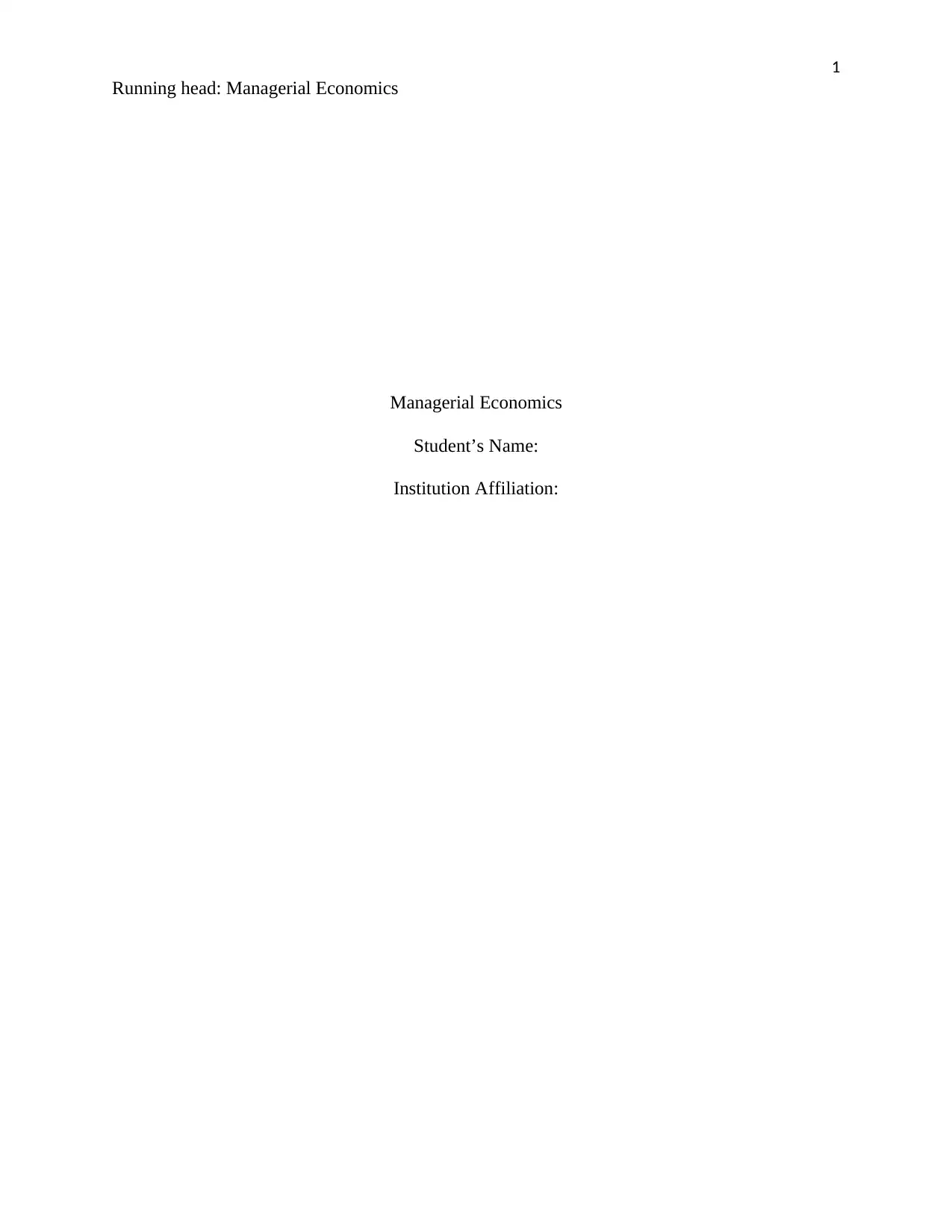
1
Running head: Managerial Economics
Managerial Economics
Student’s Name:
Institution Affiliation:
Running head: Managerial Economics
Managerial Economics
Student’s Name:
Institution Affiliation:
Paraphrase This Document
Need a fresh take? Get an instant paraphrase of this document with our AI Paraphraser
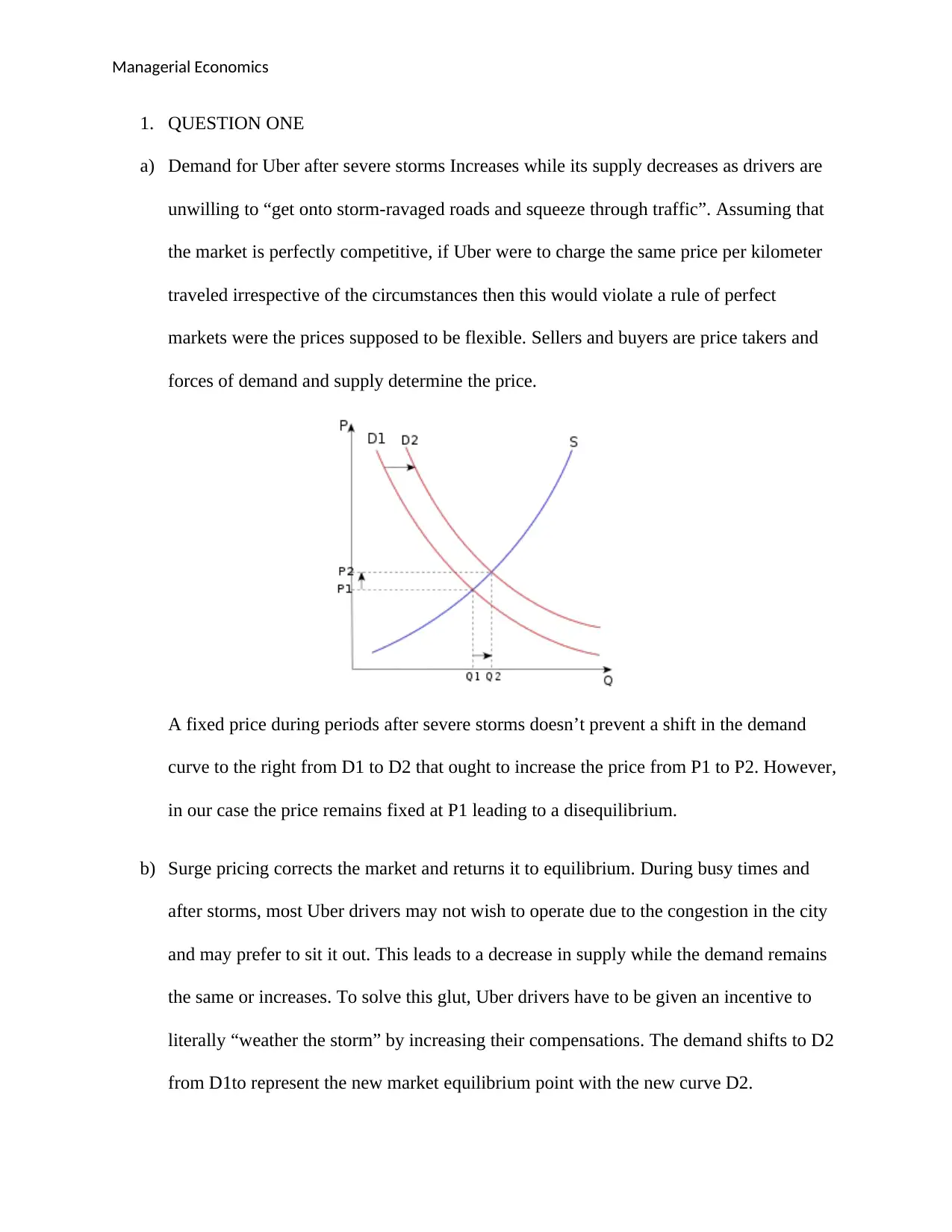
Managerial Economics
1. QUESTION ONE
a) Demand for Uber after severe storms Increases while its supply decreases as drivers are
unwilling to “get onto storm-ravaged roads and squeeze through traffic”. Assuming that
the market is perfectly competitive, if Uber were to charge the same price per kilometer
traveled irrespective of the circumstances then this would violate a rule of perfect
markets were the prices supposed to be flexible. Sellers and buyers are price takers and
forces of demand and supply determine the price.
A fixed price during periods after severe storms doesn’t prevent a shift in the demand
curve to the right from D1 to D2 that ought to increase the price from P1 to P2. However,
in our case the price remains fixed at P1 leading to a disequilibrium.
b) Surge pricing corrects the market and returns it to equilibrium. During busy times and
after storms, most Uber drivers may not wish to operate due to the congestion in the city
and may prefer to sit it out. This leads to a decrease in supply while the demand remains
the same or increases. To solve this glut, Uber drivers have to be given an incentive to
literally “weather the storm” by increasing their compensations. The demand shifts to D2
from D1to represent the new market equilibrium point with the new curve D2.
1. QUESTION ONE
a) Demand for Uber after severe storms Increases while its supply decreases as drivers are
unwilling to “get onto storm-ravaged roads and squeeze through traffic”. Assuming that
the market is perfectly competitive, if Uber were to charge the same price per kilometer
traveled irrespective of the circumstances then this would violate a rule of perfect
markets were the prices supposed to be flexible. Sellers and buyers are price takers and
forces of demand and supply determine the price.
A fixed price during periods after severe storms doesn’t prevent a shift in the demand
curve to the right from D1 to D2 that ought to increase the price from P1 to P2. However,
in our case the price remains fixed at P1 leading to a disequilibrium.
b) Surge pricing corrects the market and returns it to equilibrium. During busy times and
after storms, most Uber drivers may not wish to operate due to the congestion in the city
and may prefer to sit it out. This leads to a decrease in supply while the demand remains
the same or increases. To solve this glut, Uber drivers have to be given an incentive to
literally “weather the storm” by increasing their compensations. The demand shifts to D2
from D1to represent the new market equilibrium point with the new curve D2.
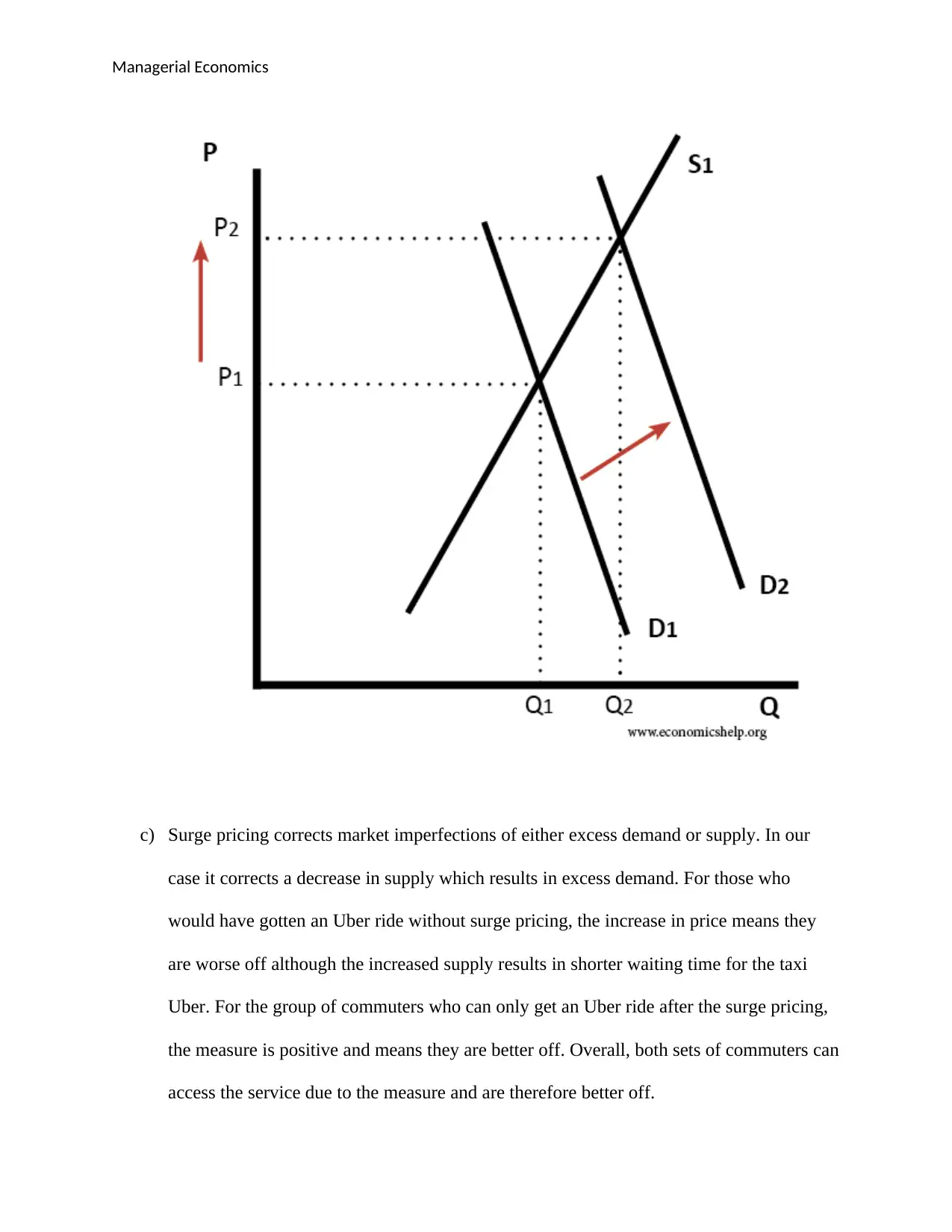
Managerial Economics
c) Surge pricing corrects market imperfections of either excess demand or supply. In our
case it corrects a decrease in supply which results in excess demand. For those who
would have gotten an Uber ride without surge pricing, the increase in price means they
are worse off although the increased supply results in shorter waiting time for the taxi
Uber. For the group of commuters who can only get an Uber ride after the surge pricing,
the measure is positive and means they are better off. Overall, both sets of commuters can
access the service due to the measure and are therefore better off.
c) Surge pricing corrects market imperfections of either excess demand or supply. In our
case it corrects a decrease in supply which results in excess demand. For those who
would have gotten an Uber ride without surge pricing, the increase in price means they
are worse off although the increased supply results in shorter waiting time for the taxi
Uber. For the group of commuters who can only get an Uber ride after the surge pricing,
the measure is positive and means they are better off. Overall, both sets of commuters can
access the service due to the measure and are therefore better off.
⊘ This is a preview!⊘
Do you want full access?
Subscribe today to unlock all pages.

Trusted by 1+ million students worldwide
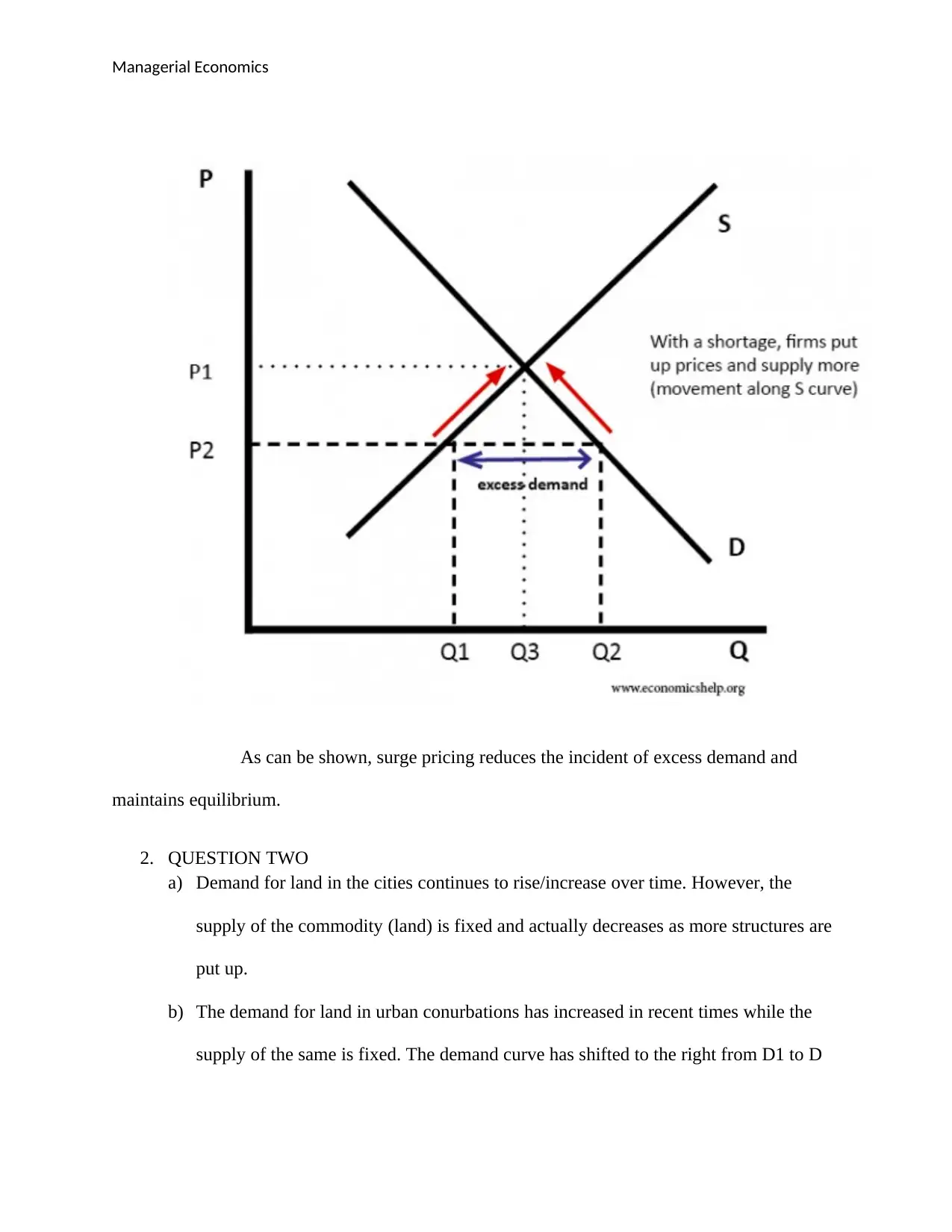
Managerial Economics
As can be shown, surge pricing reduces the incident of excess demand and
maintains equilibrium.
2. QUESTION TWO
a) Demand for land in the cities continues to rise/increase over time. However, the
supply of the commodity (land) is fixed and actually decreases as more structures are
put up.
b) The demand for land in urban conurbations has increased in recent times while the
supply of the same is fixed. The demand curve has shifted to the right from D1 to D
As can be shown, surge pricing reduces the incident of excess demand and
maintains equilibrium.
2. QUESTION TWO
a) Demand for land in the cities continues to rise/increase over time. However, the
supply of the commodity (land) is fixed and actually decreases as more structures are
put up.
b) The demand for land in urban conurbations has increased in recent times while the
supply of the same is fixed. The demand curve has shifted to the right from D1 to D
Paraphrase This Document
Need a fresh take? Get an instant paraphrase of this document with our AI Paraphraser
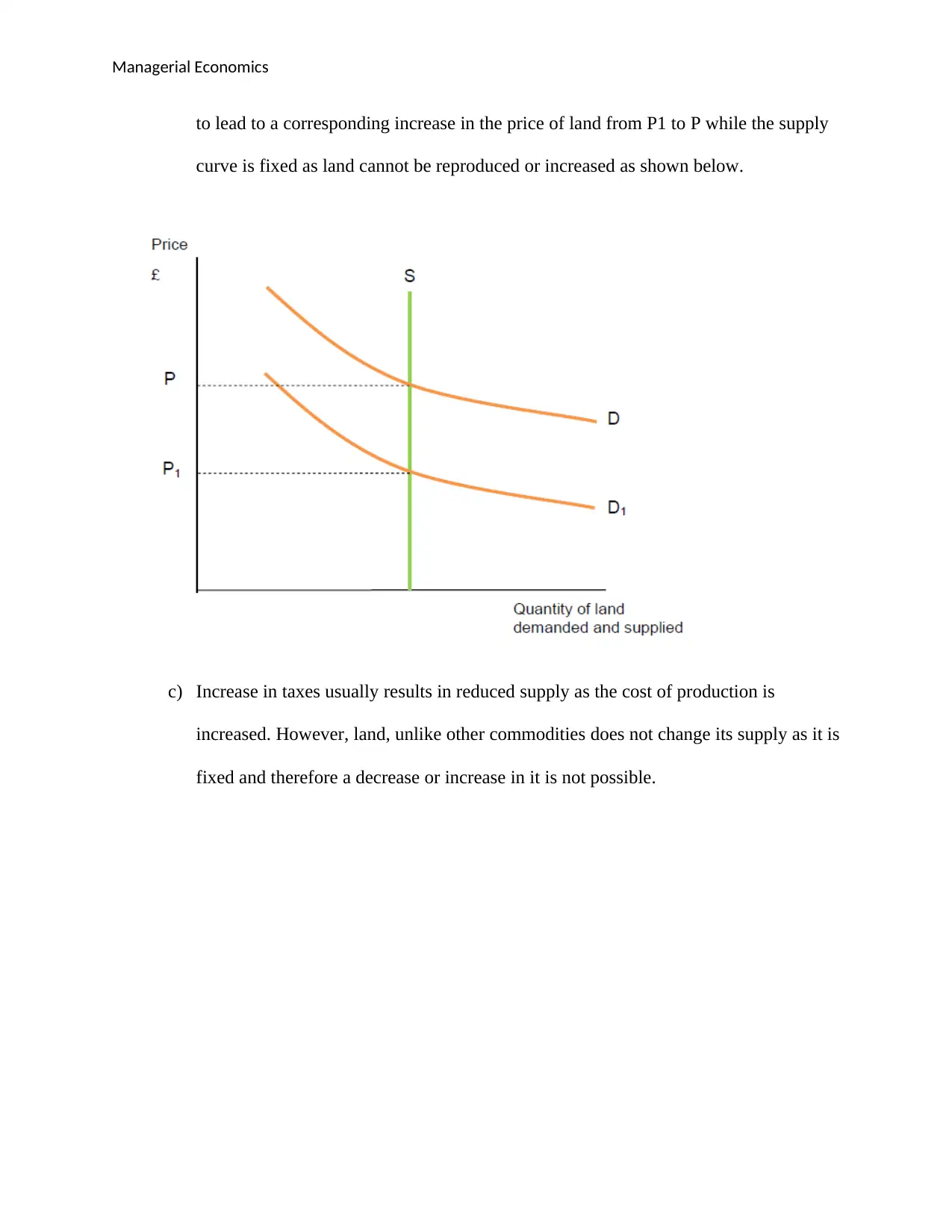
Managerial Economics
to lead to a corresponding increase in the price of land from P1 to P while the supply
curve is fixed as land cannot be reproduced or increased as shown below.
c) Increase in taxes usually results in reduced supply as the cost of production is
increased. However, land, unlike other commodities does not change its supply as it is
fixed and therefore a decrease or increase in it is not possible.
to lead to a corresponding increase in the price of land from P1 to P while the supply
curve is fixed as land cannot be reproduced or increased as shown below.
c) Increase in taxes usually results in reduced supply as the cost of production is
increased. However, land, unlike other commodities does not change its supply as it is
fixed and therefore a decrease or increase in it is not possible.
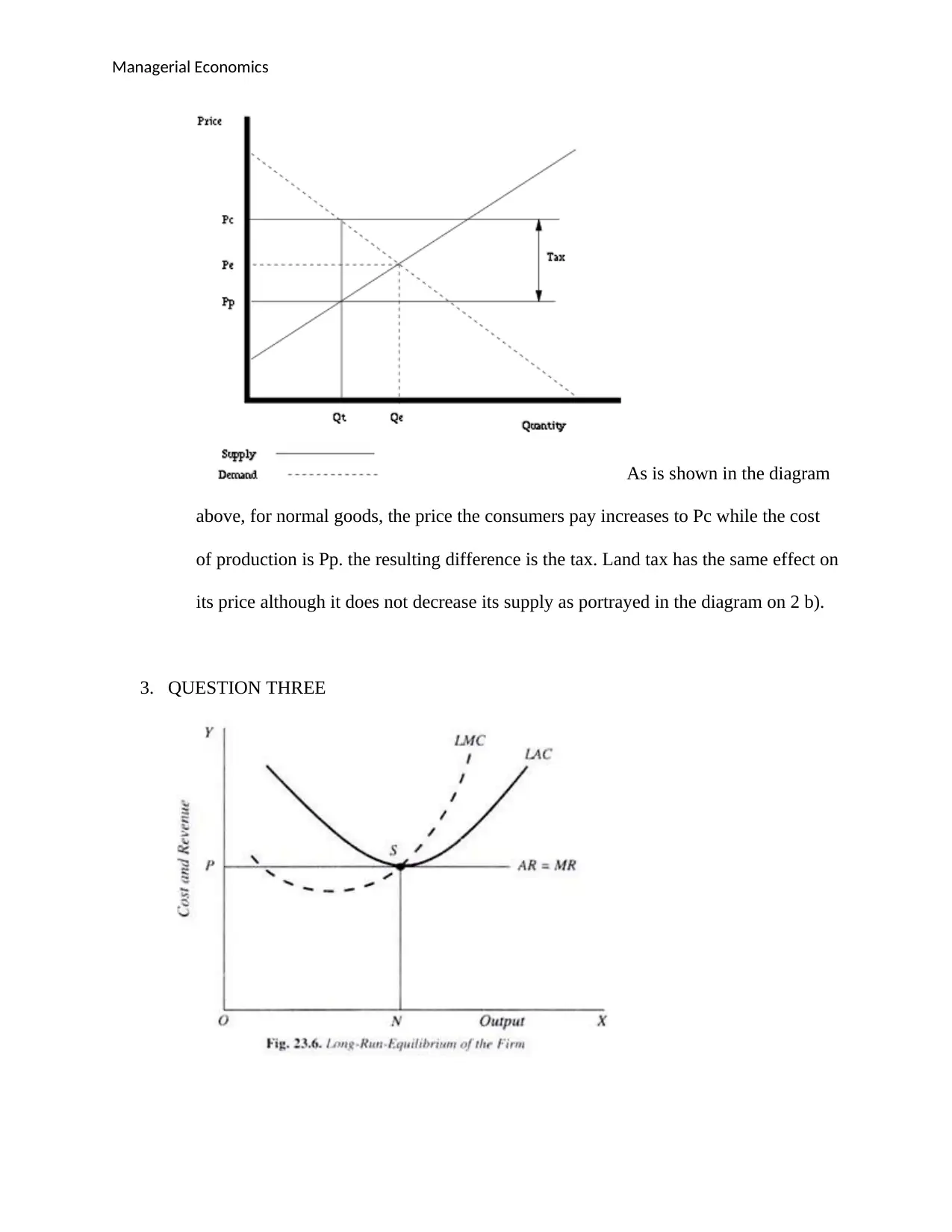
Managerial Economics
As is shown in the diagram
above, for normal goods, the price the consumers pay increases to Pc while the cost
of production is Pp. the resulting difference is the tax. Land tax has the same effect on
its price although it does not decrease its supply as portrayed in the diagram on 2 b).
3. QUESTION THREE
As is shown in the diagram
above, for normal goods, the price the consumers pay increases to Pc while the cost
of production is Pp. the resulting difference is the tax. Land tax has the same effect on
its price although it does not decrease its supply as portrayed in the diagram on 2 b).
3. QUESTION THREE
⊘ This is a preview!⊘
Do you want full access?
Subscribe today to unlock all pages.

Trusted by 1+ million students worldwide
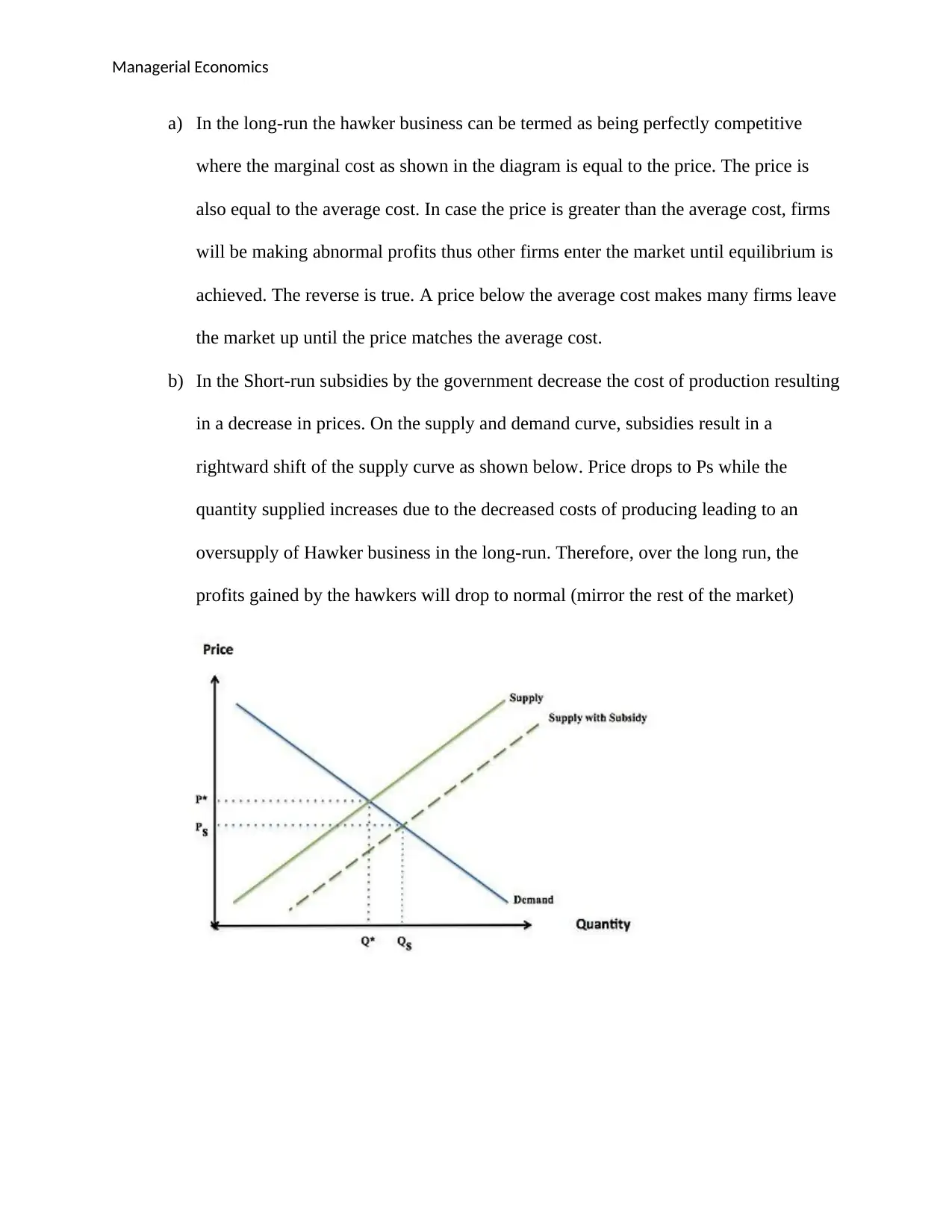
Managerial Economics
a) In the long-run the hawker business can be termed as being perfectly competitive
where the marginal cost as shown in the diagram is equal to the price. The price is
also equal to the average cost. In case the price is greater than the average cost, firms
will be making abnormal profits thus other firms enter the market until equilibrium is
achieved. The reverse is true. A price below the average cost makes many firms leave
the market up until the price matches the average cost.
b) In the Short-run subsidies by the government decrease the cost of production resulting
in a decrease in prices. On the supply and demand curve, subsidies result in a
rightward shift of the supply curve as shown below. Price drops to Ps while the
quantity supplied increases due to the decreased costs of producing leading to an
oversupply of Hawker business in the long-run. Therefore, over the long run, the
profits gained by the hawkers will drop to normal (mirror the rest of the market)
a) In the long-run the hawker business can be termed as being perfectly competitive
where the marginal cost as shown in the diagram is equal to the price. The price is
also equal to the average cost. In case the price is greater than the average cost, firms
will be making abnormal profits thus other firms enter the market until equilibrium is
achieved. The reverse is true. A price below the average cost makes many firms leave
the market up until the price matches the average cost.
b) In the Short-run subsidies by the government decrease the cost of production resulting
in a decrease in prices. On the supply and demand curve, subsidies result in a
rightward shift of the supply curve as shown below. Price drops to Ps while the
quantity supplied increases due to the decreased costs of producing leading to an
oversupply of Hawker business in the long-run. Therefore, over the long run, the
profits gained by the hawkers will drop to normal (mirror the rest of the market)
Paraphrase This Document
Need a fresh take? Get an instant paraphrase of this document with our AI Paraphraser
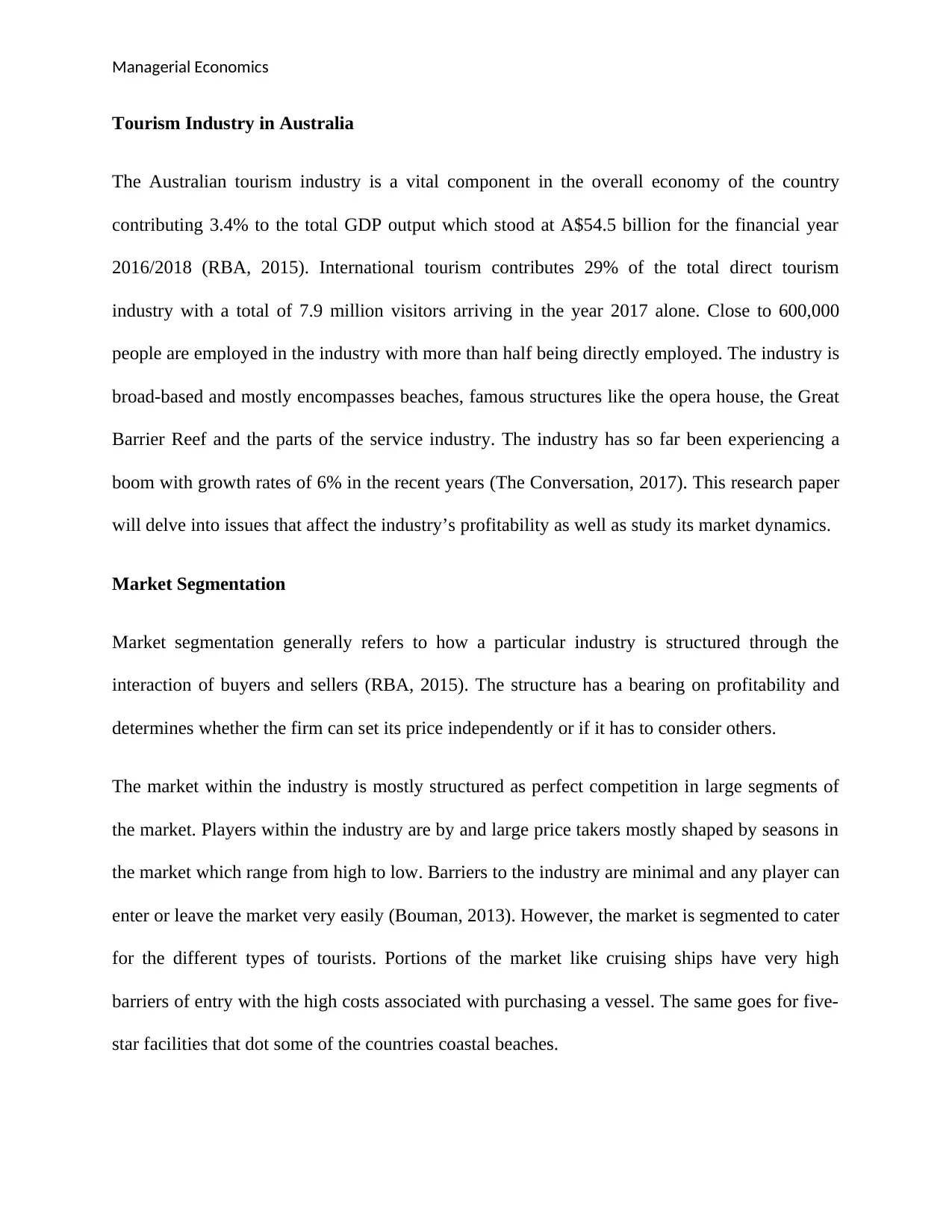
Managerial Economics
Tourism Industry in Australia
The Australian tourism industry is a vital component in the overall economy of the country
contributing 3.4% to the total GDP output which stood at A$54.5 billion for the financial year
2016/2018 (RBA, 2015). International tourism contributes 29% of the total direct tourism
industry with a total of 7.9 million visitors arriving in the year 2017 alone. Close to 600,000
people are employed in the industry with more than half being directly employed. The industry is
broad-based and mostly encompasses beaches, famous structures like the opera house, the Great
Barrier Reef and the parts of the service industry. The industry has so far been experiencing a
boom with growth rates of 6% in the recent years (The Conversation, 2017). This research paper
will delve into issues that affect the industry’s profitability as well as study its market dynamics.
Market Segmentation
Market segmentation generally refers to how a particular industry is structured through the
interaction of buyers and sellers (RBA, 2015). The structure has a bearing on profitability and
determines whether the firm can set its price independently or if it has to consider others.
The market within the industry is mostly structured as perfect competition in large segments of
the market. Players within the industry are by and large price takers mostly shaped by seasons in
the market which range from high to low. Barriers to the industry are minimal and any player can
enter or leave the market very easily (Bouman, 2013). However, the market is segmented to cater
for the different types of tourists. Portions of the market like cruising ships have very high
barriers of entry with the high costs associated with purchasing a vessel. The same goes for five-
star facilities that dot some of the countries coastal beaches.
Tourism Industry in Australia
The Australian tourism industry is a vital component in the overall economy of the country
contributing 3.4% to the total GDP output which stood at A$54.5 billion for the financial year
2016/2018 (RBA, 2015). International tourism contributes 29% of the total direct tourism
industry with a total of 7.9 million visitors arriving in the year 2017 alone. Close to 600,000
people are employed in the industry with more than half being directly employed. The industry is
broad-based and mostly encompasses beaches, famous structures like the opera house, the Great
Barrier Reef and the parts of the service industry. The industry has so far been experiencing a
boom with growth rates of 6% in the recent years (The Conversation, 2017). This research paper
will delve into issues that affect the industry’s profitability as well as study its market dynamics.
Market Segmentation
Market segmentation generally refers to how a particular industry is structured through the
interaction of buyers and sellers (RBA, 2015). The structure has a bearing on profitability and
determines whether the firm can set its price independently or if it has to consider others.
The market within the industry is mostly structured as perfect competition in large segments of
the market. Players within the industry are by and large price takers mostly shaped by seasons in
the market which range from high to low. Barriers to the industry are minimal and any player can
enter or leave the market very easily (Bouman, 2013). However, the market is segmented to cater
for the different types of tourists. Portions of the market like cruising ships have very high
barriers of entry with the high costs associated with purchasing a vessel. The same goes for five-
star facilities that dot some of the countries coastal beaches.
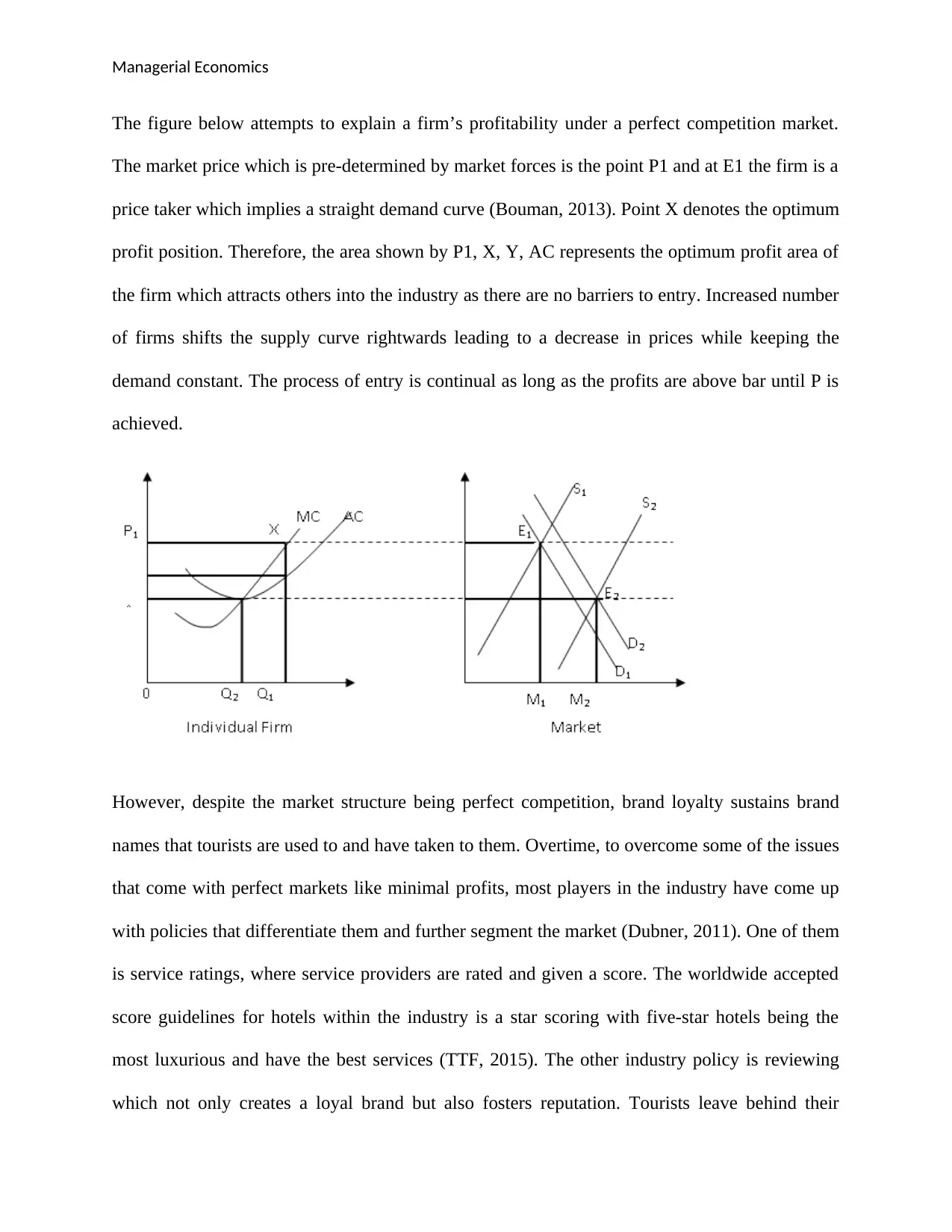
Managerial Economics
The figure below attempts to explain a firm’s profitability under a perfect competition market.
The market price which is pre-determined by market forces is the point P1 and at E1 the firm is a
price taker which implies a straight demand curve (Bouman, 2013). Point X denotes the optimum
profit position. Therefore, the area shown by P1, X, Y, AC represents the optimum profit area of
the firm which attracts others into the industry as there are no barriers to entry. Increased number
of firms shifts the supply curve rightwards leading to a decrease in prices while keeping the
demand constant. The process of entry is continual as long as the profits are above bar until P is
achieved.
However, despite the market structure being perfect competition, brand loyalty sustains brand
names that tourists are used to and have taken to them. Overtime, to overcome some of the issues
that come with perfect markets like minimal profits, most players in the industry have come up
with policies that differentiate them and further segment the market (Dubner, 2011). One of them
is service ratings, where service providers are rated and given a score. The worldwide accepted
score guidelines for hotels within the industry is a star scoring with five-star hotels being the
most luxurious and have the best services (TTF, 2015). The other industry policy is reviewing
which not only creates a loyal brand but also fosters reputation. Tourists leave behind their
The figure below attempts to explain a firm’s profitability under a perfect competition market.
The market price which is pre-determined by market forces is the point P1 and at E1 the firm is a
price taker which implies a straight demand curve (Bouman, 2013). Point X denotes the optimum
profit position. Therefore, the area shown by P1, X, Y, AC represents the optimum profit area of
the firm which attracts others into the industry as there are no barriers to entry. Increased number
of firms shifts the supply curve rightwards leading to a decrease in prices while keeping the
demand constant. The process of entry is continual as long as the profits are above bar until P is
achieved.
However, despite the market structure being perfect competition, brand loyalty sustains brand
names that tourists are used to and have taken to them. Overtime, to overcome some of the issues
that come with perfect markets like minimal profits, most players in the industry have come up
with policies that differentiate them and further segment the market (Dubner, 2011). One of them
is service ratings, where service providers are rated and given a score. The worldwide accepted
score guidelines for hotels within the industry is a star scoring with five-star hotels being the
most luxurious and have the best services (TTF, 2015). The other industry policy is reviewing
which not only creates a loyal brand but also fosters reputation. Tourists leave behind their
⊘ This is a preview!⊘
Do you want full access?
Subscribe today to unlock all pages.

Trusted by 1+ million students worldwide
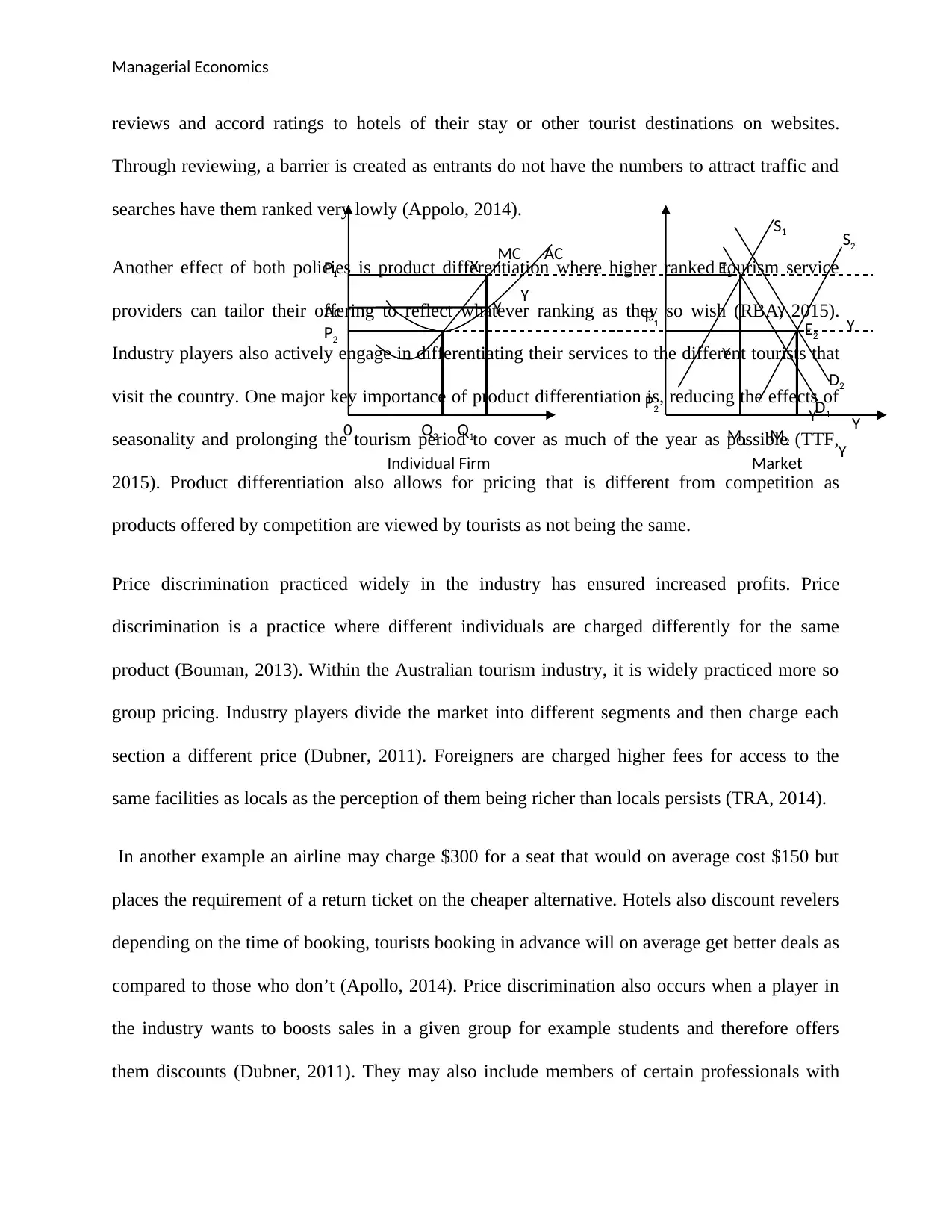
Managerial Economics
reviews and accord ratings to hotels of their stay or other tourist destinations on websites.
Through reviewing, a barrier is created as entrants do not have the numbers to attract traffic and
searches have them ranked very lowly (Appolo, 2014).
Another effect of both policies is product differentiation where higher ranked tourism service
providers can tailor their offering to reflect whatever ranking as they so wish (RBA, 2015).
Industry players also actively engage in differentiating their services to the different tourists that
visit the country. One major key importance of product differentiation is, reducing the effects of
seasonality and prolonging the tourism period to cover as much of the year as possible (TTF,
2015). Product differentiation also allows for pricing that is different from competition as
products offered by competition are viewed by tourists as not being the same.
Price discrimination practiced widely in the industry has ensured increased profits. Price
discrimination is a practice where different individuals are charged differently for the same
product (Bouman, 2013). Within the Australian tourism industry, it is widely practiced more so
group pricing. Industry players divide the market into different segments and then charge each
section a different price (Dubner, 2011). Foreigners are charged higher fees for access to the
same facilities as locals as the perception of them being richer than locals persists (TRA, 2014).
In another example an airline may charge $300 for a seat that would on average cost $150 but
places the requirement of a return ticket on the cheaper alternative. Hotels also discount revelers
depending on the time of booking, tourists booking in advance will on average get better deals as
compared to those who don’t (Apollo, 2014). Price discrimination also occurs when a player in
the industry wants to boosts sales in a given group for example students and therefore offers
them discounts (Dubner, 2011). They may also include members of certain professionals with
0 Q2 Q1 M1 M2
P1
Ac
P2
P1
P2
X
Y
MC AC
Y
S1
Y
S2
Y
D2
Y
D1
Y
E2
Y
E1
Y
Individual Firm Market
reviews and accord ratings to hotels of their stay or other tourist destinations on websites.
Through reviewing, a barrier is created as entrants do not have the numbers to attract traffic and
searches have them ranked very lowly (Appolo, 2014).
Another effect of both policies is product differentiation where higher ranked tourism service
providers can tailor their offering to reflect whatever ranking as they so wish (RBA, 2015).
Industry players also actively engage in differentiating their services to the different tourists that
visit the country. One major key importance of product differentiation is, reducing the effects of
seasonality and prolonging the tourism period to cover as much of the year as possible (TTF,
2015). Product differentiation also allows for pricing that is different from competition as
products offered by competition are viewed by tourists as not being the same.
Price discrimination practiced widely in the industry has ensured increased profits. Price
discrimination is a practice where different individuals are charged differently for the same
product (Bouman, 2013). Within the Australian tourism industry, it is widely practiced more so
group pricing. Industry players divide the market into different segments and then charge each
section a different price (Dubner, 2011). Foreigners are charged higher fees for access to the
same facilities as locals as the perception of them being richer than locals persists (TRA, 2014).
In another example an airline may charge $300 for a seat that would on average cost $150 but
places the requirement of a return ticket on the cheaper alternative. Hotels also discount revelers
depending on the time of booking, tourists booking in advance will on average get better deals as
compared to those who don’t (Apollo, 2014). Price discrimination also occurs when a player in
the industry wants to boosts sales in a given group for example students and therefore offers
them discounts (Dubner, 2011). They may also include members of certain professionals with
0 Q2 Q1 M1 M2
P1
Ac
P2
P1
P2
X
Y
MC AC
Y
S1
Y
S2
Y
D2
Y
D1
Y
E2
Y
E1
Y
Individual Firm Market
Paraphrase This Document
Need a fresh take? Get an instant paraphrase of this document with our AI Paraphraser
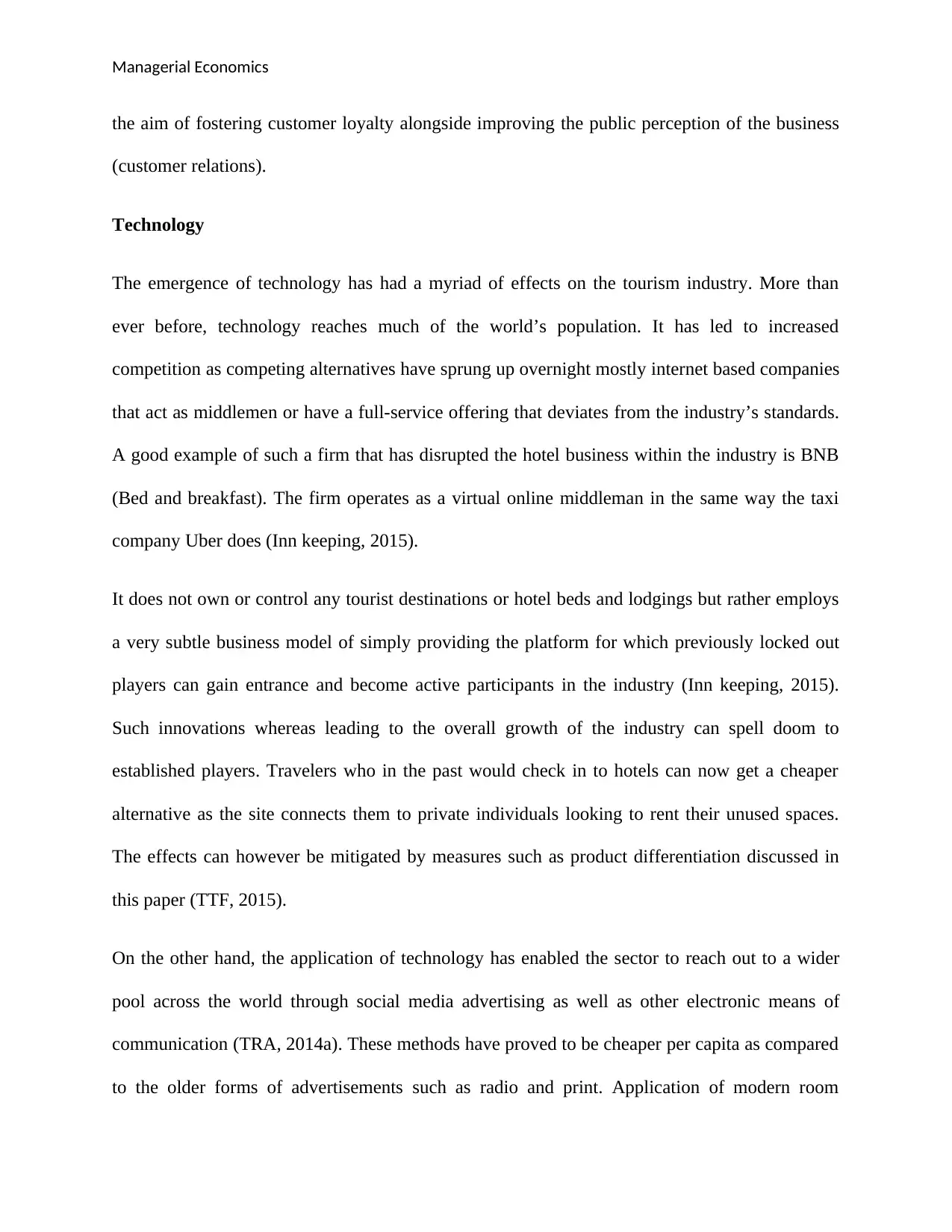
Managerial Economics
the aim of fostering customer loyalty alongside improving the public perception of the business
(customer relations).
Technology
The emergence of technology has had a myriad of effects on the tourism industry. More than
ever before, technology reaches much of the world’s population. It has led to increased
competition as competing alternatives have sprung up overnight mostly internet based companies
that act as middlemen or have a full-service offering that deviates from the industry’s standards.
A good example of such a firm that has disrupted the hotel business within the industry is BNB
(Bed and breakfast). The firm operates as a virtual online middleman in the same way the taxi
company Uber does (Inn keeping, 2015).
It does not own or control any tourist destinations or hotel beds and lodgings but rather employs
a very subtle business model of simply providing the platform for which previously locked out
players can gain entrance and become active participants in the industry (Inn keeping, 2015).
Such innovations whereas leading to the overall growth of the industry can spell doom to
established players. Travelers who in the past would check in to hotels can now get a cheaper
alternative as the site connects them to private individuals looking to rent their unused spaces.
The effects can however be mitigated by measures such as product differentiation discussed in
this paper (TTF, 2015).
On the other hand, the application of technology has enabled the sector to reach out to a wider
pool across the world through social media advertising as well as other electronic means of
communication (TRA, 2014a). These methods have proved to be cheaper per capita as compared
to the older forms of advertisements such as radio and print. Application of modern room
the aim of fostering customer loyalty alongside improving the public perception of the business
(customer relations).
Technology
The emergence of technology has had a myriad of effects on the tourism industry. More than
ever before, technology reaches much of the world’s population. It has led to increased
competition as competing alternatives have sprung up overnight mostly internet based companies
that act as middlemen or have a full-service offering that deviates from the industry’s standards.
A good example of such a firm that has disrupted the hotel business within the industry is BNB
(Bed and breakfast). The firm operates as a virtual online middleman in the same way the taxi
company Uber does (Inn keeping, 2015).
It does not own or control any tourist destinations or hotel beds and lodgings but rather employs
a very subtle business model of simply providing the platform for which previously locked out
players can gain entrance and become active participants in the industry (Inn keeping, 2015).
Such innovations whereas leading to the overall growth of the industry can spell doom to
established players. Travelers who in the past would check in to hotels can now get a cheaper
alternative as the site connects them to private individuals looking to rent their unused spaces.
The effects can however be mitigated by measures such as product differentiation discussed in
this paper (TTF, 2015).
On the other hand, the application of technology has enabled the sector to reach out to a wider
pool across the world through social media advertising as well as other electronic means of
communication (TRA, 2014a). These methods have proved to be cheaper per capita as compared
to the older forms of advertisements such as radio and print. Application of modern room
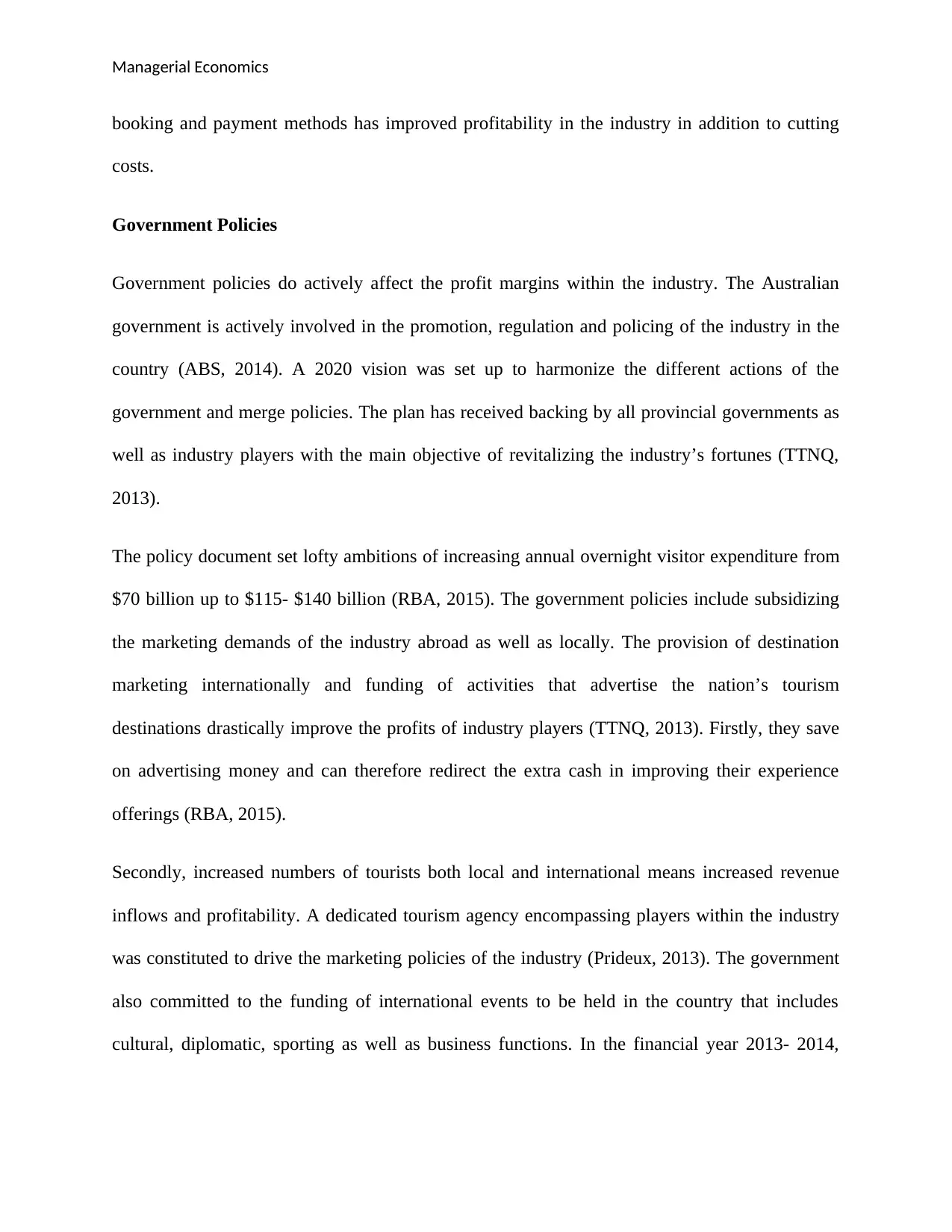
Managerial Economics
booking and payment methods has improved profitability in the industry in addition to cutting
costs.
Government Policies
Government policies do actively affect the profit margins within the industry. The Australian
government is actively involved in the promotion, regulation and policing of the industry in the
country (ABS, 2014). A 2020 vision was set up to harmonize the different actions of the
government and merge policies. The plan has received backing by all provincial governments as
well as industry players with the main objective of revitalizing the industry’s fortunes (TTNQ,
2013).
The policy document set lofty ambitions of increasing annual overnight visitor expenditure from
$70 billion up to $115- $140 billion (RBA, 2015). The government policies include subsidizing
the marketing demands of the industry abroad as well as locally. The provision of destination
marketing internationally and funding of activities that advertise the nation’s tourism
destinations drastically improve the profits of industry players (TTNQ, 2013). Firstly, they save
on advertising money and can therefore redirect the extra cash in improving their experience
offerings (RBA, 2015).
Secondly, increased numbers of tourists both local and international means increased revenue
inflows and profitability. A dedicated tourism agency encompassing players within the industry
was constituted to drive the marketing policies of the industry (Prideux, 2013). The government
also committed to the funding of international events to be held in the country that includes
cultural, diplomatic, sporting as well as business functions. In the financial year 2013- 2014,
booking and payment methods has improved profitability in the industry in addition to cutting
costs.
Government Policies
Government policies do actively affect the profit margins within the industry. The Australian
government is actively involved in the promotion, regulation and policing of the industry in the
country (ABS, 2014). A 2020 vision was set up to harmonize the different actions of the
government and merge policies. The plan has received backing by all provincial governments as
well as industry players with the main objective of revitalizing the industry’s fortunes (TTNQ,
2013).
The policy document set lofty ambitions of increasing annual overnight visitor expenditure from
$70 billion up to $115- $140 billion (RBA, 2015). The government policies include subsidizing
the marketing demands of the industry abroad as well as locally. The provision of destination
marketing internationally and funding of activities that advertise the nation’s tourism
destinations drastically improve the profits of industry players (TTNQ, 2013). Firstly, they save
on advertising money and can therefore redirect the extra cash in improving their experience
offerings (RBA, 2015).
Secondly, increased numbers of tourists both local and international means increased revenue
inflows and profitability. A dedicated tourism agency encompassing players within the industry
was constituted to drive the marketing policies of the industry (Prideux, 2013). The government
also committed to the funding of international events to be held in the country that includes
cultural, diplomatic, sporting as well as business functions. In the financial year 2013- 2014,
⊘ This is a preview!⊘
Do you want full access?
Subscribe today to unlock all pages.

Trusted by 1+ million students worldwide
1 out of 16
Related Documents
Your All-in-One AI-Powered Toolkit for Academic Success.
+13062052269
info@desklib.com
Available 24*7 on WhatsApp / Email
![[object Object]](/_next/static/media/star-bottom.7253800d.svg)
Unlock your academic potential
Copyright © 2020–2025 A2Z Services. All Rights Reserved. Developed and managed by ZUCOL.




